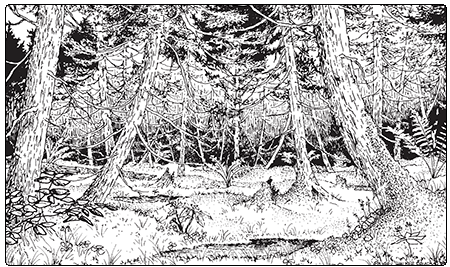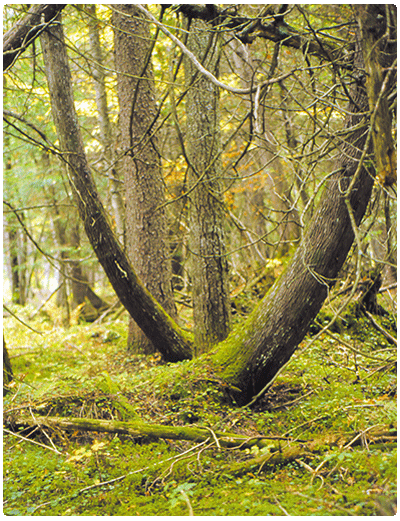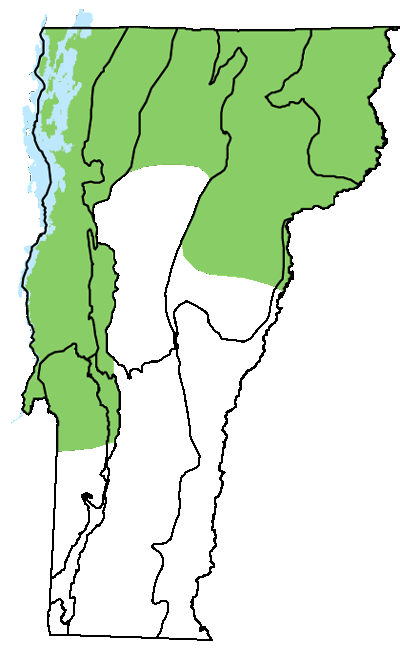Ecology and Physical Setting 
Mossy hummocks, water-filled hollows, and the chance of finding a rare plant or beautiful orchid have long attracted naturalists to Northern White Cedar Swamps.
The typical Northern White Cedar Swamp in Vermont is a closed canopy swamp associated with mineral-enriched groundwater seepage. These swamps occur in a variety of physical settings, including wetland basins, lakesides, and valley bottoms adjacent to streams. They occur on many bedrock types, but where bedrock or till is calcareous, the seepage is more enriched and species diversity is higher. Northern White Cedar Swamps range in size from several acres to over 100 acres, but the majority are smaller than 40 acres.
Northern White Cedar Swamps have organic soil horizons that are shallow to deep, up to 18 feet. These organic soils are primarily well-decomposed peat, often with wood fragments throughout. Water in these swamps is circumneutral to slightly acidic and originates mostly from seeps and springs at the edges of the swamps. Although Northern White Cedar Swamps occur in stream valleys and adjacent to lakes and ponds, they typically do not flood.
Vegetation 
The generally closed canopy of Northern White Cedar Swamps creates a dark, cool forest floor. Leaning trees and blowdowns are common and result in well-developed hummocks and hollows. Hollows often contain shallow standing water. Because of the low light levels, shrubs and herbs are sparse, though diversity can be high. The shaded forest floor, with its abundant moisture, is ideal for mosses and liverworts, which often carpet the ground. Overall, Northern White Cedar Swamps have a rich flora.
Northern white cedar dominates the low, closed canopy of these swamps, and in some areas, cedar may be the only tree species present. Northern white cedar is a long-lived species. It is not uncommon to find cedars over 200 years old growing in our swamps. Balsam fir is the most common canopy associate. Occasional tall white pine, red spruce, and tamarack emerge above this low canopy. The tall and short shrub layers are sparse, although several species are characteristic. These include Canada honeysuckle, alder-leaved buckthorn, Canada yew, and mountain maple. Seedling and sapling regeneration of cedar and balsam fir forms dense thickets in areas where blowdowns open the canopy and more light reaches the forest floor. When live cedar trees are blown down, it is common to see one or more of their branches become the next generation of trees.
The herbaceous layer of Northern White Cedar Swamps is also sparse and is typically made up of fine-leaved sedges and low herbs scattered over mossy hummocks and hollows. Dwarf raspberry creeps along the ground. Other species include three-seeded sedge, bristle-stalked sedge, pedunculate sedge, naked mitrewort, oak fern, fowl mannagrass, one-sided pyrola, and dewdrop. Stair-step moss, shaggy moss, common fern moss, and Sphagnum warnstorfii often form nearly complete carpets over the hummocks and the drier hollows. Three-lobed bazzania caps old stumps. Hollows with standing water support several distinctive mosses, including Calliergon cordifolium and starry campylium. Groundwater seeps are common at the edges of cedar swamps and are often dominated by golden saxifrage and several species of bryophytes. Because of their calcium-rich waters, Northern White Cedar Swamps provide habitat for an impressive number of rare plants. Some of the beautiful rare orchids that are found in Northern White Cedar Swamps include fairy-slipper, ram’s head lady’s slipper, small yellow lady’s slipper, and showy lady’s slipper.
Wildlife Habitat
Northern White Cedar Swamps provide winter cover for white-tailed deer. Cedar twigs and needles are also a preferred winter food for deer. Southern red-backed voles favor moist coniferous woods, and the seeps and mossy roots in cedar swamps provide habitat for these small rodents. The dense thickets of young cedar in swamp openings provide ideal cover for snowshoe hare. Beaver are often present in Northern White Cedar Swamps that are associated with perennial streams. Their impoundments are an important form of natural disturbance.
Common breeding birds of Northern White Cedar Swamps include winter wren, northern waterthrush, Canada warbler, northern parula, yellow-rumped warbler, and white-throated sparrow. Yellow-bellied flycatcher and rusty blackbird are northern species and rare breeders in Vermont—they both breed in the cedar swamps of northeastern Vermont. Northern saw-whet owls nest in old woodpecker cavities in cedar swamps. Although secretive, a saw-whet owl may stay perched on a lower cedar branch and just watch you as you approach. In warmer regions of Vermont, especially the Champlain Valley, blue-spotted salamanders and four-toed salamanders may be found in these mossy, wet swamps.
Related Communities
- Boreal Cedar-Sphagnum Basin Swamps also have northern white cedar in the canopy but are found in cold basins and lack species indicative of groundwater seepage and enrichment. Sphagnum dominates the swamp floor, to the near exclusion of other bryophytes.
- Northern White Cedar Seepage Forests occur on sloping terrain with either mineral soil or shallow organic soil, where calcareous water flows at or near the surface. These are often adjacent to Northern White Cedar Swamps. Bryophyte cover is low, and twigs and needles cover the forest floor.
- Rich Fens may occur as small inclusions within Northern White Cedar Swamps. Because of the mineral-rich groundwater source, the two communities have a number of species in common, but fens are too wet to support tree growth.
- Red Maple-Northern White Cedar Swamps are distinguished by an abundance of red maple, and seasonal flooding from nearby rivers. These two communities can intergrade, especially in the Champlain Valley.
Conservation Status and Management Considerations
Northern White Cedar Swamps are uncommon in Vermont. Because of the value of cedar wood for shingles and posts, logging has occurred in most cedar swamps and there are very few undisturbed examples. Logging with heavy machinery is not recommended because it may alter the soil, hydrology, and species composition of these swamps. Roads, culverts, and other infrastructure can also alter the hydrology of cedar swamps, especially when beavers take advantage of these structures to build dams. Many good examples of Northern White Cedar Swamps are protected on state and private conservation lands. Vermont has a disproportionate abundance of northern white cedar swamps compared to neighboring states, so these conserved examples have regional conservation importance.
Distribution/Abundance 
Northern White Cedar Swamps occur from Ontario and the Great Lakes states through northern New York and New England, and east to the Maritime Provinces. In Vermont, they are most common across northern regions, and extend south in the Taconic Mountains.
Characteristic Plants
Trees
Abundant Species
Northern white cedar – Thuja occidentalis
Balsam fir – Abies balsamea
Occasional to Locally Abundant Species
Black ash – Fraxinus nigra
Yellow birch – Betula alleghaniensis
White pine – Pinus strobus
Tamarack – Larix laricina
Red spruce – Picea rubens
White spruce – Picea glauca
Red maple – Acer rubrum
Paper birch – Betula papyrifera
Eastern hemlock – Tsuga canadensis
Shrubs
Abundant Species
Canada honeysuckle – Lonicera canadensis
Alder-leaved buckthorn – Rhamnus alnifolia
Occasional to Locally Abundant Species
Canada yew – Taxus canadensis
Mountain maple – Acer spicatum
Winterberry holly – Ilex verticillata
Mountain holly – Ilex mucronata
Wild raisin – Viburnum nudum var. cassinoides
Red-osier dogwood – Cornus sericea
Speckled alder – Alnus incana
Herbs
Abundant Species
Three-seeded sedge – Carex trisperma
Two-seeded sedge – Carex disperma
Bristle-stalked sedge – Carex leptalea
Pedunculate sedge – Carex pedunculata
Naked mitrewort – Mitella nuda
Dwarf raspberry – Rubus pubescens
Bunchberry – Cornus canadensis
Goldthread – Coptis trifolia
Twinflower – Linnaea borealis
Common wood sorrel – Oxalis montana
Starflower – Lysimachia borealis
Occasional to Locally Abundant Species
Bladder sedge – Carex intumescens
Fowl mannagrass – Glyceria striata
Cinnamon fern – Osmundastrum cinnamomeum
Oak fern – Gymnocarpium dryopteris
One-sided pyrola – Orthilia secunda
Dewdrop – Rubus dalibarda
Long beech fern – Phegopteris connectilis
Crested wood fern – Dryopteris cristata
Foamflower – Tiarella cordifolia
Broad-lipped twayblade – Neottia convallarioides
One-flowered pyrola – Moneses uniflora
Creeping snowberry – Gaultheria hispidula
Golden saxifrage – Chrysosplenium americanum
Swamp saxifrage – Micranthes pensylvanica
Bryophytes
Abundant Species
Stair-step moss – Hylocomium splendens
Shaggy moss – Rhytidiadelphus triquetrus
Three-lobed bazzania – Bazzania trilobata
Moss – Sphagnum warnstorfii
Common fern moss – Thuidium delicatulum
Occasional to Locally Abundant Species
Liverwort – Trichocolea tomentella
Moss – Sphagnum squarrosum
Moss – Sphagnum subtile
Moss – Sphagnum centrale
Moss – Calliergon cordifolium
Moss – Calliergon giganteum
Moss – Rhizomnium punctatum
Moss – Amblystegium riparium
Starry campylium – Campylium stellatum
Rare and Uncommon Plants
Sheathed sedge – Carex vaginata
Marsh valerian – Valeriana uliginosa
Fairy-slipper – Calypso bulbosa
White adder’s mouth – Malaxis monophyllos var. brachypoda
Ram’s head lady’s slipper – Cypripedium arietinum
Sweet coltsfoot – Petasites frigidus var. palmatus
Bog wintergreen – Pyrola asarifolia
Showy lady’s slipper – Cypripedium reginae
Swamp thistle – Cirsium muticum
Swamp fly honeysuckle – Lonicera oblongifolia
Mountain fly honeysuckle – Lonicera villosa
Small round-leaved orchis – Amerorchis rotundifolia
Thin-flowered sedge – Carex tenuiflora
Small yellow lady’s slipper – Cypripedium parviflorum var. makasin
Green adder’s mouth – Malaxis unifolia
Small bog orchis – Platanthera obtusata
Moss – Calliergon richardsonii
Moss – Meesia triquetra
Associated Animals
Northern dusky salamander – Desmognathus fuscus
Black bear – Ursus americanus
White-tailed deer – Odocoileus virginianus
Moose – Alces americanus
Masked shrew – Sorex cinereus
Bobcat – Lynx rufus
Southern red-backed vole – Myodes gapperi
Snowshoe hare – Lepus americanus
Winter wren – Troglodytes hiemalis
Northern waterthrush – Parkesia noveboracensis
Canada warbler – Cardellina canadensis
Northern parula – Parula americana
Yellow-rumped warbler – Setophaga coronata
White-throated sparrow – Zonotrichia albicollis
Rare and Uncommon Animals
Blue-spotted salamander – Ambystoma laterale
Four-toed salamander – Hemidactylium scutatum
Rock vole – Microtus chrotorrhinus
Yellow-bellied flycatcher – Empidonax flaviventris
Rusty blackbird – Euphagus carolinus
Northern saw-whet owl – Aegolius acadicus
Places to Visit
Long Pond Natural Area, Greensboro, The Nature Conservancy
Roy Mountain Wildlife Management Area, Barnet, Vermont Fish and Wildlife Department (VFWD)
Dolloff Ponds and Marl Pond, Willoughby State Forest, Sutton and Westmore, Vermont Department of Forests, Parks, and Recreation (VDFPR)
Victory Basin Wildlife Management Area, Victory, VFWD
Pine Mountain Wildlife Mangement Area, Topsham, VFWD
Stoddard Swamp, Groton State Forest, VDFPR
Bliss Pond Cedar Swamp, Calais Town Forest
Tinmouth Channel Wildlife Management Area, Tinmouth, VFWD
